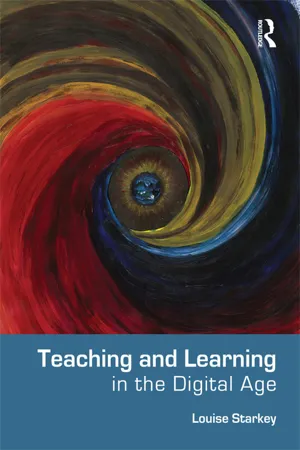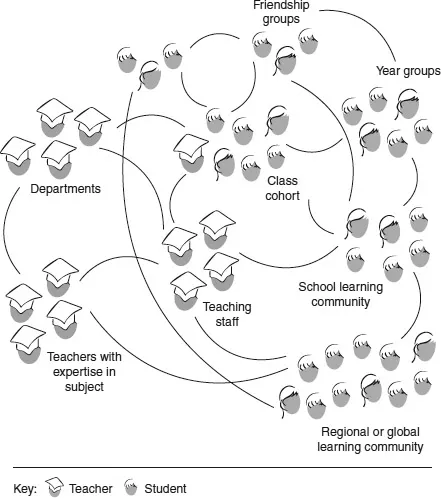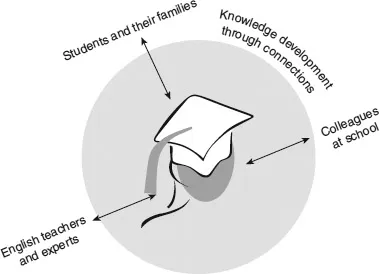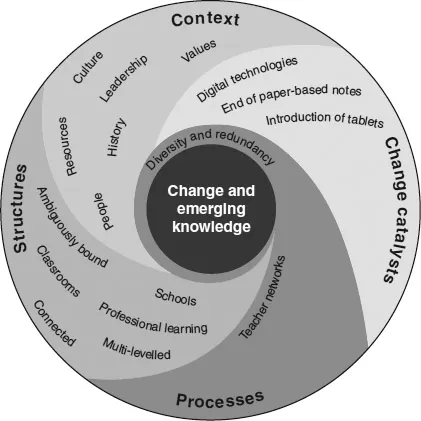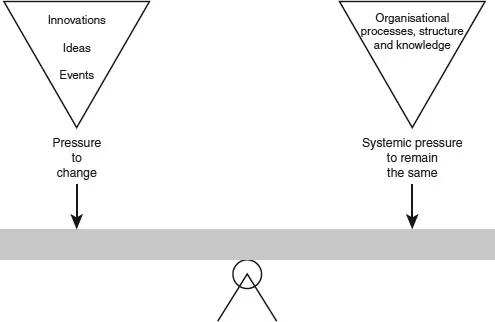![]()
Chapter 1
The complexity of schools
Schools are complex places and learning is a complex process. This chapter outlines the perspective through which educational or schooling systems are considered within this book. Complexity theory underpinned the way that research is considered, experiences are framed, and the thinking about how teaching and learning might occur within the digital age.
Educational systems are organised with multilevel structures (classes, year levels, departments, timetables, and calendars), they include a range of participants (students, teachers, governors or administrators, leaders, policy makers, families, communities, and agencies), and are required to meet an assortment of changing expectations (social, professional, achievement, and financial). Complexity theory offers a framework to consider teaching and learning in the digital age within the context of schooling and educational systems.
Complexity theory
In 2000 Stephen Hawking predicted that the next century would be the century of complexity (Chui, 2000). Over time theories are reviewed and new ideas and ways of examining society emerge based on concepts relevant to the time and context. Complexity theory has emerged from the physical sciences where exploration of how communities of organisms change is focused on the complexity of the systems rather than individual cause and effect processes within a deterministic universe. The theory is being applied to the social sciences to examine how complex systems, such as education, evolve and develop over time.
Complexity theory has a number of interrelated constructs which can be explored through examining context, structures, catalysts for change, and knowledge creation processes within an organisation or system (Figure 1.1).
A complex system or organisation consists of a number of levels, with each level having a recognisable open boundary (Waldrop, 1992). At each level there are connections between the parts where knowledge emerges through interaction. There are many organisational levels in a school setting. Schools have formal structures, which may include classes, year levels, subject based departments, syndicates, teacher committees, leadership groups and governance boards. Figure 1.2 illustrates a few of the levels that can exist within a schooling system. Each of these levels has its own set of knowledge and processes, which develop over time.
The boundaries of the levels within an organisation are open in that membership can change, information and ideas are exchanged beyond and between these levels, and the levels overlap with individuals and resources belonging to multiple levels. Experiences and knowledge gained from one level will be applied and shared at other levels. Therefore knowledge and ideas at one level are transferred to other levels. None of the levels are independent; they are connected so that events, ideas or innovations emerging through one level will potentially affect other levels.
Figure 1.1 Complexity theory applied to a school context.
A secondary school teacher is typically a member of one or more classes, they may belong to more than one subject department, be on the assessment committee and the curriculum committee, organise outdoor education and belong to the teaching staff (Figure 1.3). For example, an English teacher forms a connection with students and their families as they teach, lead extracurricular activities and discuss learning progress. The same teacher has connections with colleagues at school through formal and informal groups that they belong to, and as an English teacher they connect with other English teachers through subject based networks.
Schools belong to communities, districts and national schooling networks. Knowledge or ideas are exchanged beyond the organisational boundaries of a school, such as through regional or national subject teacher associations, principal networks and community events. Schools are ambiguously bound organisations. It is not possible (or desirable) to control how and what knowledge is exchanged within and across the boundaries, which contributes to the unpredictability of emerging knowledge and responses to changes within a complex system such as a school.
Figure 1.2 Simplified levels within a complex organisation.
The context of a complex organisation
Each organisation or complex system operates in a unique context. The uniqueness is derived from the people, history and culture of the context. Each school has a range of employees, leaders, governors, students and families, each bringing differing beliefs, perspectives, expectations and experiences to their interactions within the school. Teachers have differing perspectives on pedagogical practices, which will filter how they perceive or implement a particular innovation within their teaching practice (this point is explored further in this book when considering teaching and learning with digital technologies). School leaders each have their own leadership style depending on their personality, knowledge, beliefs, experiences and the school context they are leading. The leadership influences how and what knowledge emerges within a school (Robinson et al., 2009). A school leader can, through direct and indirect support of an innovation, encourage teaching staff, students and parents to engage with a change. A leader in a different school context may not verbally support the same innovation or introduce support processes, which can result in different value being put on the same innovation by the staff and students at the two different contexts. It is not only the leader that influences change but also the embedded organisational knowledge.
Figure 1.3 Connections from a teacher’s perspective within a complex organisation.
Complex systems or organisations draw on their history as they evolve over time (Buchanan, 2000). In a schooling context this includes knowledge of how a process of change has occurred in the past or particular values that have developed and underpin an organisation or the levels within an organisation. Each school has a unique culture that has emerged over its history through the people, events and the context in which it exists (Senge et al., 2000) and each level within an organisation has a unique culture. For example, the way that the English department makes decisions about curriculum may differ from the science department. One may have a top-down approach that is focused on compliance; the other may have a consultative approach structured around negotiated department goals. The history of a school and the people within it influence the culture of a school, including the way that change occurs and how knowledge emerges.
Emerging knowledge through connections
Complexity theory is a way of considering how knowledge emerges within a complex organisation. Stacey (2001) noted that human relations lie at the heart of complexity theory where the agency and mutual influence of individuals and groups create a responsive process. Connections between individual, groups and resources across the organisational levels are where ideas, innovations and events are discussed, evaluated and sometimes modified and embedded. It is through these connections that knowledge emerges, building or modifying what is known by the collective group. Knowledge can emerge through conversations between teachers in a school or department, discussions with parents, reading of research, examining data, meetings, online information exchange with other educationalists or conversations in the classroom setting. Participants in the system respond to the context, thereby changing the context while developing their own ideas and knowledge (Davis and Sumara, 2006). While schools, education systems and classrooms can appear to be top-down driven, there is research that reflects how the relationships, history and culture within each level influences change from the bottom up (Bishop and Glynn, 1999; Senge et al., 2000; Wink, 2000). Emerging knowledge is influenced by the parts, participants and processes within the system.
Morrison (2002) examined complexity theory within the context of schools and school leadership. He noted that by limiting research within schools to the individual parts, the whole picture can be misunderstood. He proposed that it is impossible to predict what the outcomes of one aspect of change will be in a school as there are so many connections that will influence the response.
Connections occur at multiple levels including external connections between people or devices and internal connections made during the learning process. John Dewey noted that when learning, perceptions cannot be separated from judgements as isolated aspects of learning do not make sense until they are connected within a wider context. Connections are an important aspect of learning and knowledge creation.
Diversity and redundancy
A complex system like a school is in a state of constant change with the regular introduction or emergence of new ideas, innovations and events. If every suggestion, idea or proposal was implemented the school would be in a state of chaos. Therefore complex organisations go through processes of evaluating, disregarding and trialling innovations and new ideas, which creates diversity of practice, ideas and systems. Other innovations and longstanding practices or ideas become redundant and are discontinued or replaced. Consider an example of an innovation such as the introduction of a digital technology (for example netbooks) for students (Figure 1.4). Such an introduction could create change in practices in the school, and from this knowledge will emerge. It would not be predictable exactly what will change as it will depend on contextual factors such as the beliefs and knowledge of individuals and groups, current practices, resources and interactions across the organisation. New understandings (or knowledge) will emerge through the connections between the parts of the organisation as experiences and ideas are discussed and shared. With the introduction of a netbook other practices or ideas may become redundant, such as the use of paper student diaries, the need for student lockers, the idea that all students in a class must be physically present in the classroom to be participating interactively in the learning. Diversity and redundancy are likely to be unique to each specific context dependent on the history, culture and other variables such as the preferences and experiences of teachers, values and beliefs and the resourcing available. Through this process of diversity and redundancy, knowledge emerges through connections in complex organisations.
Complexity exists between deterministic order and randomness, the place referred to as the ‘edge of chaos’. It is logical that when a system is closer to the edge of chaos there is likely to be increased levels of redundancy and diversity within the processes and practices than found in a stable controlled environment. Conditions of emergent learning within a classroom setting were examined through the application of a complexity theory (Sullivan, 2009). Emergent learning was found to occur in a classroom environment on the edge of chaos, where students had a sense of agency and the learning context was loosely bound. This compared to a classroom with a tightly bound learning environment where the edge of chaos was avoided and there was minimal student agency. In this latter context emergent learning was undetectable.
Figure 1.4 Complexity within schools as a new technology is introduced.
Balancing randomness and deterministic order
A complex system is not static, which adds to its unpredictability when faced with a change. A complex organisation faces ongoing change in its structures, participants, parts, processes and knowledge. In a schooling environment there are pupils (and their families) joining and leaving, staff changes, changing curriculum, resources updated, new content knowledge to teach, district or national policy changes, emerging knowledge from research and practitioner experience and many other changes, all of which contribute to the complexity of the context. The resulting changes are a balance between randomness and deterministic order (Cilliers, 1998).
Schools are influenced by apparent randomness such as technological innovations, natural events, government policy initiatives and societal changes, which create pressure for change within the system. They are also influenced by deterministic pressures such as systems knowledge, routines and values. The pressure to change or innovate acts like a counterweight to the pressure to remain the same (Figure 1.5). It is through the apparent randomness and deterministic order that knowledge emerges, as ideas or innovations become part of organisational knowledge.
Figure 1.5 Balancing randomness and deterministic order.
When the pressures of new ideas, events or innovations outweigh deterministic order new knowledge can emerge within a system. In a system such as a school that is close to the edge of chaos the deterministic order is less influential and the decision makers may be more receptive to initiatives or new ideas. For example, a school with a diverse population that gives a voice to all the groups within the school might operate on the edge of chaos with the pressure to implement innovations stronger than the systemic pressure to remain the same (Figure 1.6).
This is unlikely to occur if the context is in a state of chaos,...
